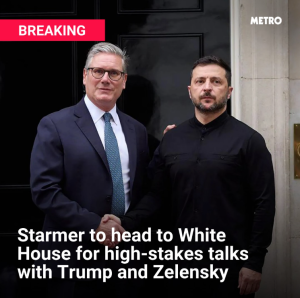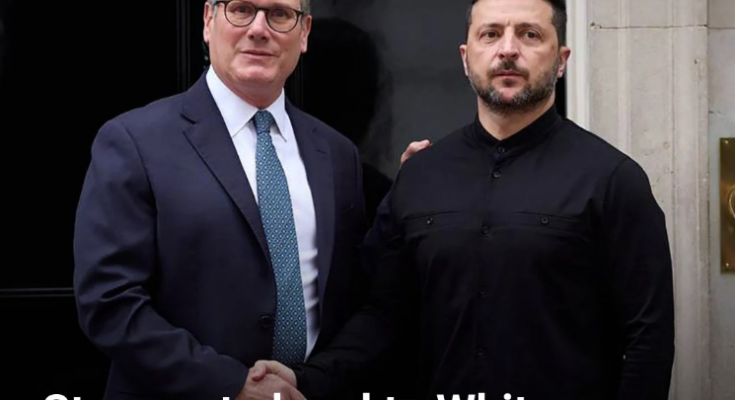Starmer to Join Zelensky at the White House for a Meeting with Donald Trump
In a development that could reshape the trajectory of the war in Ukraine, leaders from across Europe are heading to Washington to join Ukrainian President Volodymyr Zelensky for a high-stakes summit with U.S. President Donald Trump. Among the most prominent figures making the trip is British Prime Minister Sir Keir Starmer, whose role has become increasingly pivotal in bridging the gap between European priorities and Trump’s unorthodox diplomacy.
The White House gathering, scheduled for August 18, comes just days after Trump’s headline-grabbing summit with Russian President Vladimir Putin in Alaska. That meeting ended without a ceasefire but with signals of a possible peace deal, though one that might require Ukraine to cede territory in Donbas. The suggestion sparked alarm across Europe, where leaders worry that Ukraine could be pressured into concessions that undermine its sovereignty and embolden future aggression.
Why This Meeting Matters
The Washington summit is not just another diplomatic gathering; it represents a defining moment in the ongoing war and in Western unity. For Trump, it is a chance to present himself as the deal-maker who can end a bloody conflict that has dragged on for over three years. For Zelensky, it is about survival—ensuring that Ukraine is not sacrificed at the altar of geopolitical expediency. And for Starmer and other European leaders, it is about drawing a red line: peace cannot come at the cost of forced territorial losses.
The European delegation will include Starmer, French President Emmanuel Macron, German Chancellor Friedrich Merz, and European Commission President Ursula von der Leyen. Their joint presence underscores the seriousness of the moment. Instead of leaving Zelensky to face Trump alone, Europe is arriving in force, sending the clear message that the continent stands firmly behind Kyiv.
The Alaska Aftershock
Trump’s Alaska meeting with Putin revealed two competing visions of peace. Putin’s demand was straightforward: Ukraine should withdraw from Donetsk and Luhansk in exchange for an end to hostilities. Trump did not reject the proposal outright, fueling speculation that he could endorse a deal requiring Ukraine to give up land.
This prospect has shaken allies. European leaders argue that such concessions would not only betray Ukraine but also undermine international law by rewarding an aggressor. A dangerous precedent would be set, one that could embolden similar territorial claims elsewhere.
At the same time, Trump’s envoy Steve Witkoff hinted that Putin might agree to allow NATO-like, Article 5-style security guarantees for Ukraine. If true, this could represent a major shift, offering Kyiv stronger protection against future aggression. Yet the credibility of such guarantees remains in question. Would they carry real military backing, or would they be little more than words on paper?
Starmer’s Calculated Role
Starmer has emerged as a surprising key player in these talks. Despite vast ideological differences with Trump, the British Prime Minister has managed to maintain a functional working relationship with him. This gives Starmer the ability to act as both translator and bridge—softening European demands in language Trump finds palatable while still defending the principles of sovereignty and international law.
Earlier this year, Starmer hosted the London Summit on Ukraine, which created the so-called Coalition of the Willing. This group of states pledged to provide Ukraine with security and diplomatic support even as Washington’s position wavered. Starmer’s decision to attend the Washington summit highlights his intent to keep the coalition aligned with U.S. efforts, but not at any cost.
His strategy is to steer Trump toward security guarantees that empower Ukraine without requiring it to surrender territory. Publicly, Starmer has praised Trump’s willingness to engage with Putin. Privately, he is expected to press the case that Europe will not support any peace plan imposed on Ukraine against its will.
Europe’s United Front
The collective presence of European leaders in Washington is not symbolic theater alone. It is meant to give Zelensky leverage and prevent a repeat of February’s Oval Office clash between him and Trump. That meeting ended in chaos, with Trump pausing U.S. military and intelligence support for Ukraine after a heated exchange.
This time, European leaders want to ensure that Zelensky is not cornered. Macron and Merz are expected to back him strongly, while von der Leyen will stress the principle that borders cannot be changed by force. The Europeans will also push for a ceasefire as a first step toward peace, whereas Trump is rumored to prefer jumping directly to a final deal.
What’s at Stake
For Ukraine, the stakes are existential. The prospect of ceding Donetsk and Luhansk would be politically devastating at home, where public sentiment overwhelmingly opposes giving up land. For Zelensky personally, it would represent a betrayal of the very mission that has defined his presidency: defending Ukraine’s sovereignty.
For Europe, the stakes are broader. A weakened Ukraine could destabilize the continent, creating a precedent that borders are negotiable under pressure. Leaders fear that if Russia’s aggression is rewarded, other authoritarian states may attempt similar moves in different parts of the world.
For Trump, the stakes are political as much as geopolitical. Ending the Ukraine war on his terms would bolster his image as the president who can deliver peace where others failed. But if he is seen as bullying Ukraine into concessions, he risks alienating allies and undermining U.S. leadership in Europe.
What to Watch
Several key questions will define the outcome of the summit.
-
Will Trump support territorial concessions? If he openly endorses Putin’s demands, expect immediate pushback from Zelensky and European leaders.
-
Will credible security guarantees be offered? The difference between symbolic promises and enforceable commitments will determine whether Ukraine feels secure in any deal.
-
How united will Europe remain? A fractured European response could weaken Zelensky’s position, while a unified stance would increase pressure on Trump to align.
-
Will there be progress toward a ceasefire? Europe views a ceasefire as an essential first step, while Trump appears eager to bypass it.
The Road Ahead
This meeting is unlikely to produce a final peace deal, but it could set the tone for negotiations to come. If the summit results in agreement on credible security guarantees and a framework for talks without territorial concessions, it will be hailed as a success. If, however, it leaves Ukraine isolated or pressured into making painful compromises, it will deepen divisions between Washington and Europe.
Conclusion
The White House summit is more than a diplomatic photo opportunity—it is a test of whether the West can remain united in the face of Russian aggression. Zelensky arrives in Washington determined to hold the line on Ukraine’s sovereignty. Starmer and other European leaders are at his side to strengthen his hand and signal that Europe will not allow Ukraine to be bargained away. Trump, true to form, holds the cards of unpredictability. Whether he plays them in pursuit of a just peace or a quick political win will define not just the future of Ukraine, but the credibility of the Western alliance itself.

